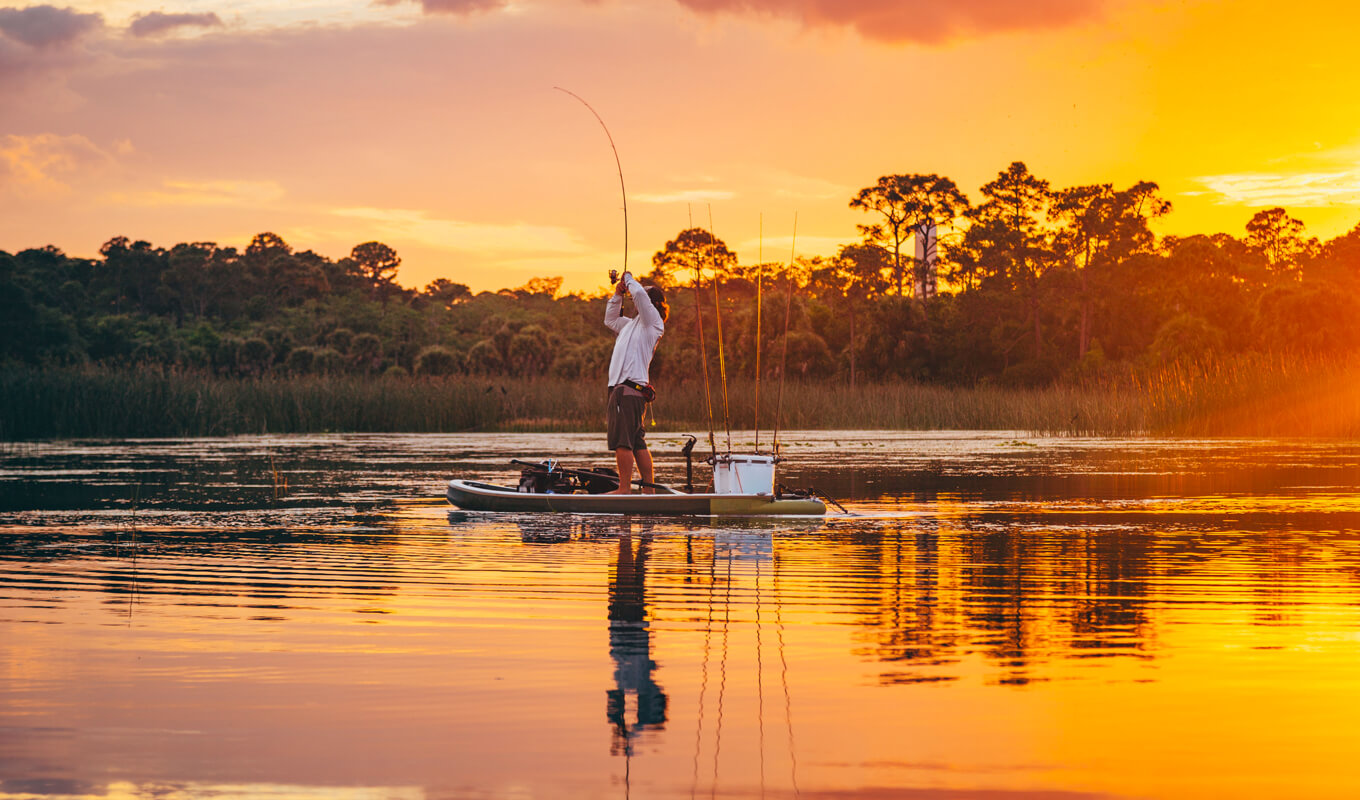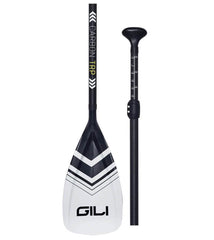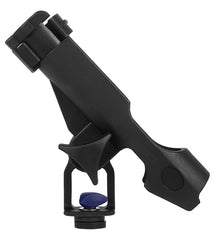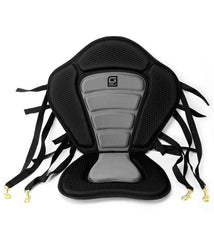Tu carrito está vacío

The sun is peeking over the horizon and the fish are biting. It’s time to load your tackle, fishing rods, and gear to catch some fish.
We’ll help you to find the best fishing paddle board to make your day a success!

There are many advantages to fishing from a paddle board.
Let’s be honest… paddle boarding is more fun!

Let’s review the best paddle boards that could make your day of fishing one to remember.
| Inflatable SUP Boards | Measurements | Weight | Weight Capacity | Price |
| 12' x 32" x 6" | 23 lbs | 330 lbs | ||
| 11.6' x 35" x 6" | 24 lbs | 485 lbs | ||
|
12' x 45" x 8" 15' x 56" x 8" |
35 lbs 52 lbs |
725 lbs 1150 lbs |
||
| 12.6' x 40" x 6" | 45 lbs | 500 lbs | ||
| 12.8' x 38" x 7" | 45 lbs | 400 lbs | ||
| 11' x 39" x 7" | 30 lbs | 300 lbs | ||
| 11'6 x 34" x 6" | 29 lbs | 485 lbs | ||
|
12' x 32" x 8" 14' x 34" x 8" |
48 lbs 50 lbs |
350 lbs 400 lbs |
The GILI Adventure is an extremely stable inflatable paddle board with numerous attachment points to load your fishing rod holder, cooler, and tackle. The GILI Adventure comes in both an 11 foot and a 12 foot length, but the 12 foot option provides the ideal space for SUP fishing.
The GILI is decked out with action mounts, Scotty mounts, and numerous D-rings to attach all the gear you might need. It has a large EVA deck pad to comfort your feet when fishing all day.
| Measurements | Weight | Weight Capacity | Price |
| 12' x 32" x 6" | 23 lbs | 330 lbs |
| PROS | CONS |
|
|
The GILI Meno is a stable paddle board with an extra-wide 35” deck for loads of space for a wide stance and room to move around, and added space to pack extra gear. Compared to other inflatable SUPs, the GILI Meno package includes many upgrades including a carbon fiber rail for extra rigidity and stability to the board, as well as a dual-chamber inflation pump, rolling SUP backpack, and a carbon fiber paddle.
The Meno has numerous attachment points with eight action mounts and 18 D-rings for your deck cooler, Go Pro, or cup holder. Front and rear bungee cargo areas have ample storage space.
| Measurements | Weight | Weight Capacity | Price |
| 11.6' x 35" x 6" | 24 lbs | 485 lbs |
| PROS | CONS |
|
|
The GILI Manta Ray comes in two size options and both sizes would make great fishing paddle boards. The Manta Ray is a mammoth of a board with a wide deck built for multiple riders, but if you’re headed out for a solo fishing venture, that means room for extra gear and a friend.
With a total of nine action mounts, you can attach cup holders, multiple fishing rod holders, bring a cooler, and extra tackle - you have the room! The Manta Ray’s durable construction and quality build mean it's a board your whole family can enjoy for years to come.
| Measurements | Weight | Weight Capacity | Price |
|
12' x 45" x 8" 15' x 56" x 8" |
35 lbs 52 lbs |
725 lbs 1150 lbs |
| PROS | CONS |
|
|
The Sea Eagle is a SUP fisherman’s dream because of the extra features that cater specifically to fishing. The extra wide deck and 500-pound weight capacity mean there’s room for two on board. An added bonus is that it comes with an electric motor as a motorized SUP option to save your energy for catching fish.
The Sea Eagle includes a seat to rest when your legs tire of standing as well as fishing rulers to size up your catch immediately. These features set the Sea Eagle apart from other SUPs.
| Measurements | Weight | Weight Capacity | Price |
| 12.6' x 40" x 6" | 45 lbs | 500 lbs |
| PROS | CONS |
|
|
The Bote Rackham Aero is an inflatable stand up paddle board with a large deck space and the capacity to be a great fishing SUP. It has a unique two-chamber design with a recessed deck to provide extra stability.
Bote allows room for heavy accessorizing with many ways to attach fishing gear. With a 400 lbs weight capacity, you could bring a friend. The Bote package comes with a few items unique to Bote, including a paddle sheath to insert your paddle when reeling your fishing pole, Rac receivers to attach Rac buckets or tackle racks, and a sand spear sheath to hold your anchor spear secure in shallow water.
| Measurements | Weight | Weight Capacity | Price |
| 12.8' x 38" x 7" | 45 lbs | 400 lbs |
| PROS | CONS |
|
|
The NRS Heron has a simple overall design, but it has everything you need in a fishing SUP. It has two unique dual chambers that when inflated, add extra thickness and width for an extremely stable paddle board.
There is room for your tackle in the front and rear cargo areas and it has added daisy rigging for additional accessories. The NRS board is lightweight and easy to carry, but the entire package can be heavy to carry over distances.
| Measurements | Weight | Weight Capacity | Price |
| 11' x 39" x 7" | 30 lbs | 300 lbs |
| PROS | CONS |
|
|
The Blackfin Model XL is a great all around SUP with a stable overall design to make it perfect for SUP fishing. The Blackfin XL has a wide deck to allow a stable stance and has a tremendous weight capacity of 485 lbs!
The Blackfin has action mounts, Scotty mounts, and numerous D-rings to attach all the fishing gear that you need, and the 2021 model now includes attachment points for the addition of a fishing rack. It is a durable, well-built board with a complete package to get you right onto the water.
| Measurements | Weight | Weight Capacity | Price |
| 11'6 x 34" x 6" | 29 lbs | 485 lbs |
| PROS | CONS |
|
|
The Bote Rackham is the only solid paddle board on our list, and it has the qualities of a great fishing SUP. As a solid board, it will naturally perform better than an inflatable SUP and has excellent tracking and glide through the water. Similar to other Bote SUPs, it includes Power Rac attachment points for Rac buckets and tackle racks to hold all of your fishing gear. Rac systems are inserts for your board to store more gear.
The Bote Rackham has a wide deck, and it’s a stable board with a high weight capacity for multiple riders or loads of gear. The Bote Rackham is also a nice all around paddle board to double for non-fishing activities. The long narrow design would make a nice SUP touring board as well.
| Measurements | Weight | Weight Capacity | Price |
|
12' x 32" x 8" 14' x 34" x 8" |
48 lbs 50 lbs |
350 lbs 400 lbs |
| PROS | CONS |
|
|

There are many benefits to fishing from a stand up paddle board, and we’ve introduced you to our favorite fishing SUPs. In order to determine which paddle board is best suited for you, let’s review some basic SUP fishing guidelines.
There are many different features to evaluate when choosing the best fishing SUP but it will ultimately come down to how you wish to use your board and in what environment. Do you also want to use your fishing paddle board to float with friends? Do you plan to bring along your dog or child? There are many considerations.
This is the most important factor when choosing a paddle board. When fishing, you want to cast your line and reel in a fish, without the risk of falling overboard. Finding a stable SUP is your goal.
The wider, thicker, and longer the paddle board, the more stable it will be. For a fishing SUP, look for a width of at least 31 inches, 6 inches of thickness, and at least 11 feet long for the best stability. A long, wide board will not turn or maneuver as easily, but it does allow for good tracking as you fish down the shoreline.
When you’re fishing, you have lots of gear - your fish finder, fishing poles, and favorite lures. Find a stand up paddle board with multiple attachment points including D-rings, action mounts, and Scotty mounts.
Your D-rings provide attachment points for bungees to secure your deck cooler or dry bag. You can even attach a seat for your SUP with a kayak conversion kit. Action mounts provide attachment of fishing rod holders and cup holders. A good fishing SUP will also have Scotty mounts, which are a more universal attachment used across all boat and fishing accessories options. You can mount your GPS directly to a Scotty mount.

A stand up paddle board needs to hold your own body weight and that of your fishing gear, ans most can can easily accommodate this, with one or two passengers. For SUP fishing, consider the cargo space and bungees available in the front or rear as well as the action mounts or Scotty mounts that can be utilized to attach rod holders or fish finders.
When you plan to stand and fish for many hours, you’ll want a padded, comfortable surface under your feet. Look for a large deck pad for comfort, but also one with added brushings or grooves to provide the traction needed to avoid slipping.
Paddling around the lake is not your primary goal when SUP fishing, but you’ll still want a paddle to get you to your destination quickly and with little effort. An aluminum paddle is the cheapest option if you want something durable, but it tends to be heavier than fiberglass or carbon fiber options. A carbon fiber paddle with a carbon blade is the best paddle because it is lightweight, durable, and performs well.
A paddle holder is great when SUP fishing, because it provides a safe way to rest your paddle so you can concentrate on fishing. When reeling in the big one, you don’t want to worry about your paddle floating away.
Look to purchase your paddle board from a company that stands by their SUPs with a warranty. Reputable companies will offer a money back guarantee if you’re not satisfied with your paddle board purchase as well as a warranty. In the rare instance that your stand up paddle board malfunctions, it’s important to know that you’ll be able to talk to the company without any hassle.
Certain fishing equipment is essential for SUP fishing and shouldn’t be forgotten for a successful day of fishing. Most SUP fishing paddle boards will come with all you need to hop directly onto the water right out of the box.
Obviously… you need a fishing SUP decked out with the proper gear.

You won’t get very far without a paddle. As stated earlier, consider a lightweight paddle and a SUP with a paddle holder for hands-free fishing. In order of increasing quality, paddles come in aluminum, fiberglass, and carbon fiber options.

Always attach your ankle leash to a D-ring for safety. If you happen to fall from your board, an ankle leash ensures that your SUP full of gear does not shoot across the water for you to chase.

A personal flotation device (PFD) is a must-have item for your own safety, as well as a legal requirement in some locations.

The ability to attach your fishing pole securely to your SUP makes it less likely that it will end up on the bottom of the lake. Fishing rod holders affix to action mounts and Scotty mounts and are a convenient option to secure your fishing rod.

An anchor makes SUP fishing easier because when wind, waves, or current continuously push you out of your fishing hole, you have to paddle back into position. A SUP anchor easily clips to a D-ring at the nose or rear and makes it easier to concentrate on your fishing pole instead of the paddle.

A deck cooler for your beverages ensures that you stay hydrated when fishing long hours on a sunny day, and can be stored in the bungee cargo area or secured to D-rings. This keeps your cold drinks within grasp, instead of you paddling back to shore.

When SUP fishing, you want to have both hands free to reel in fish or cast your line. You obviously will need to paddle at times, but a paddle holder provides safe storage so your paddle doesn’t end up in the water - as your fish gets away. Some fishing SUPs have a built in paddle holder along the rail, but a paddle leash is another option.

Standing on your SUP offers a great vantage point to see the water and fish habitat, but sometimes you get tired and simply want to sit. A kayak conversion kit transforms your stand up paddle board into a kayak easily as you attach it to available D-rings.

An inflatable SUP needs to be inflated before you can hit the water, and sometimes it’s simply not fast enough! For a faster fill consider an electric pump. Simply plug it into your vehicle’s cigarette lighter and go.

When fishing, your SUP will be loaded with gear and you’ll be shifting your weight as you cast and reel in your line. Stabilizers attach to your stand up paddle board to make it more stable, and help you concentrate less on balancing so you can focus on the fish.

A dry bag is waterproof and seals shut to secure your valuables such as your wallet, keys, or cell phone. You can throw in an extra sweatshirt or towel if needed and a dry bag will keep it safe and dry.

If you want your phone handy to shoot photos of the huge fish you’ve caught, then use a waterproof phone case. It seals shut to keep it dry, but you can operate the buttons right through the case to take pictures or use your GPS. It comes with a lanyard to wear around your neck for quick access.

When the fish are hard to find, consider a fish finder to track the underwater movements and find the lunkers hiding below. The Garmin Striker adapts well to fishing SUPs with a transducer arm that easily attaches to a Scotty mount and extends the fish finder below the SUP.

If fishing in the pre-dawn hours or after dark, attach a SUP fishing light. Not only is it required in some areas by law, but it also helps you find your gear in the dark, and make your SUP visible to oncoming vessels. Many can be easily attached via suction cup directly to your SUP.

Let’s review some helpful advice to help prepare you for a safe day on the water.
Don’t lose your valuable gear in the water by making sure it is secured properly. Use bungees to secure your cooler and tackle in the cargo areas, or hook larger containers such as coolers or tackle boxes to available D-rings. Pack your phone, towel, and other valuables in your dry bag to keep them from getting wet.
Don’t get stranded at the other end of the lake when a thunderstorm hits. Watch the wind and storm advisories and prepare accordingly. If high winds are predicted, it is probably not the best day for SUP fishing because you’ll spend so much time fighting the wind that you won’t have time to fish.
Before loading up your fishing SUP with all of your gear and heading onto the water, make sure you’ve mastered your paddle board skills. Your balance will be tested with a paddle board full of supplies when you reel in a fish, so you want to be comfortable with your skill level before putting it to the ultimate test. Familiarize yourself with your board and take it out on a few trial runs before your first big fishing expedition.
Even though fishing from a paddle board offers added stealth to sneak up on fish, you still want to minimize your movement while paddling and fishing so you don’t scare them away. Every paddle and shift on your board will send ripples and waves in the water. The more you practice, the more you’ll paddle efficiently and quietly to find more fish.
When reeling in a big fish, lowering to your knees will provide more stability. Avoid sitting down completely, because then you lose your core strength to help reel in the fish.
Trolling is also an option on a paddle board. Let the wind blow your board across the cove while you work your line downwind. As you paddle down the shoreline, gain a good cruising speed, stow your paddle, and cast your line toward shore.
Even though most fishing SUP typically have bungee storage areas and D-ring attachments, it still doesn't have the capacity to bring everything. Choose wisely and trim down unnecessary gear. Put as much small gear in your dry bag and consider doubling your cooler as a seat. Once you’ve decided on the optimal gear, distribute it evenly on your stand up paddle board to maintain balance.
Get your fishing license and wear your PFD where you’re legally obligated to do so. Store your fishing license in your dry bag to keep it dry onboard your SUP. Fines for keeping fish illegally can be easily avoided.
The bottom line is to have fun on your fishing SUP. Find a quiet cove and soak up the sounds of nature, while waiting for the fish to bite. A stand up paddle board is a great way to relax and enjoy a nice float on the water.
The best fishing paddle board is out there waiting to be loaded with your tackle box, cooler, fishing rods, and enthusiasm. Hopefully, you’ve got all the information you need to choose a fishing paddle board that’s guaranteed to bring home fish!
Yes! Fishing from a paddle board is not only possible, but an excellent way to catch fish. While on a stand up paddle board, you have a great vantage point to see the water with plenty of open space to cast and reel your fishing pole. SUP fishing allows you to maneuver into tight spaces that a boat cannot access and then approach quietly so you don’t scare the fish. Plus, a paddle board is much less expensive than a new boat.
Any of the Fishing SUPs listed here work equally well for fly fishing. The key to fly fishing is having a wide-open space around you to work your line, and a paddle board offers the perfect setup. While standing on a SUP, you have the height advantage to see the water and place your fly in the perfect location. A fishing SUP is easy to transport to remote trout streams and quiet paddling allows you to sneak up on the fish with ease.
When planning on a long day of fishing, don’t forget to pack your cooler. The GILI deck cooler is a great option to pack up to twenty 12oz cans for your trip and easily secure it in the SUP bungee cargo space or cinch it down to D-rings. It comes with a convenient carry strap and bungees.
An inflatable SUP is recommended for fishing over a solid paddle board. Even though a solid SUP can perform better than an inflatable paddle board, an inflatable has the advantage of versatility. You can trek to a mountain lake with your inflatable SUP easily, due to its light weight and portability thanks to a SUP backpack. An inflatable fishing stand up paddle board is durable with many attachment points to load your fishing gear, and is typically less expensive than a solid SUP.
The biggest consideration in choosing a fishing SUP is its stability. Look for a board at least 31 inches wide and 11 feet long to provide a wide stable stance with plenty of room to move. Fishing paddle boards should have action mounts and Scotty mounts to attach your fishing rod holders and fish finders. Look for ample bungee storage space for your tackle and cooler.
You can expect to pay anywhere from $699 - $1699 for a fishing stand up paddle board, which is pretty good compared to a new kayak or boat. This provides a good baseline price range, but typically the quality of the board will mirror its price in most cases. The cheapest boards might not necessarily be the most durable or have quality accessories.
Los comentarios se aprobarán antes de mostrarse.